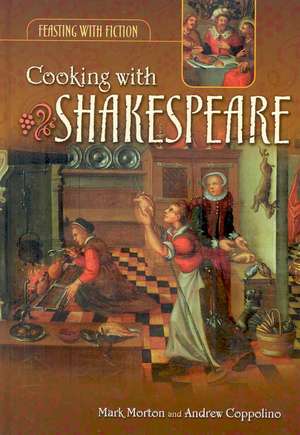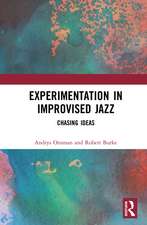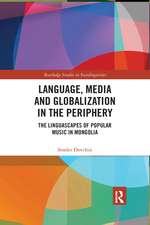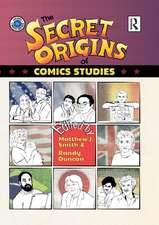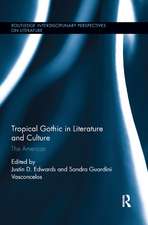Cooking with Shakespeare: Feasting with Fiction
Autor Mark Morton, Andrew Coppolinoen Limba Engleză Hardback – 29 mar 2008 – vârsta până la 17 ani
Preț: 267.87 lei
Preț vechi: 455.15 lei
-41% Nou
Puncte Express: 402
Preț estimativ în valută:
51.30€ • 52.86$ • 42.98£
51.30€ • 52.86$ • 42.98£
Carte tipărită la comandă
Livrare economică 24 februarie-10 martie
Preluare comenzi: 021 569.72.76
Specificații
ISBN-13: 9780313337079
ISBN-10: 0313337071
Pagini: 336
Dimensiuni: 178 x 254 x 24 mm
Greutate: 0.86 kg
Editura: Bloomsbury Publishing
Colecția Greenwood
Seria Feasting with Fiction
Locul publicării:New York, United States
ISBN-10: 0313337071
Pagini: 336
Dimensiuni: 178 x 254 x 24 mm
Greutate: 0.86 kg
Editura: Bloomsbury Publishing
Colecția Greenwood
Seria Feasting with Fiction
Locul publicării:New York, United States
Notă biografică
MARK MORTON is Senior Instructional Developer (Technology) in the Centre for Teaching Excellence at the University of Waterloo. Previously, he taught courses in Shakespeare, Modern Drama, and Creative Writing at the University of Winnipeg. His other books include Cupboard Love: A Dictionary of Culinary Curiosities (1996), The End: Closing Words for a Millennium (1999), and The Lover's Tongue: A Merry Romp through the Language of Love and Sex (2003). Mark also writes a quarterly column for Gastronomica: A Journal of Food and Culture, and has written and broadcast more than a hundred columns about language for CBC Radio.ANDREW COPPOLINO is a freelance writer, restaurant reviewer, and newspaper columnist with a special interest in food writing. He has published in Restaurant Report, Culinary Trends, Whisky Magazine, CityFood Magazine, Gremolata, and Canadian Gaming Business, as well as a number of food and lifestyle magazines.
Cuprins
PrefaceAcknowledgmentsWilliam Shakespeares Works and Their Abbreviations1. Introduction2. House Fowl3. Beef and Veal4. Mutton and Lamb5. Pork6. Game7. Fish and Seafood8. Vegetables9. Eggs and Dairy10. Fritters, Fricassees, and Puddings11. Broths, Pottage, and Sops12. Breads, Wafers, and Pastry Shells13. Salads14. Pies and Tarts15. Biscuits and Spiced Breads16. Stewed Fruits, Candied Spices, and Sugar Plate17. Sauces and Powders18. BeveragesAppendix 1: Hard to Find IngredientsAppendix 2: Wages and PricesAppendix 3: A First Course and the Second Course for Fish DaysAppendix 4: Dialogue for TabletalkeGlossaryBibliographyIndex
Recenzii
This book ventures beyond literature and cookery into history, etymology, and sciences..Thorough, exemplary, logical, and unflinchingly authentic, the volume is a labor of love and thoughtful scholarship. Offering 189 recipes (some delicious), the book features a 67-page introduction on period ideology, dietary theory, law, pharmacology, etiquette, and economics. There are four appendixes, including Hard to Find Ingredients (substitutions/sources for hyssop, isinglass, verjuice, etc.) and Wages and Prices..The recipes are irresistible to read, if not always to cook--baked porpoise, swan's-blood pudding, and an aphrodisiac tart with sparrows' brains (the authors suggest substituting a teaspoon of Spam). In the fully quoted and cited original recipes, the authors note details that might escape readers' attention, e.g., carving breast meat from a live chicken..This wonderful book joins such titles as Francine Segan's Shakespeare's Kitchen: Renaissance Recipes for the Contemporary Cook (2003). Highly Recommended.
A rich, fun survey of early cooking methods and recipes for modern readers and librarians interested in culinary history.
Cooking with Shakespeare is packed with information that will interest culinary historians, lovers of Shakespeare, and foodies alike.
The introduction outlines the material and ideological conditions surrounding the production and consumption of food in Shakespeare's time. Each of the 189 entries couples a recipe taken from an early modern source with a related reference in Shakespeare, a short discussion of important terms in the recipe or quotation, and a translation of the recipe into modern terms..Bon appetit.
.Cooking with Shakespeare should set a new standard for cookbooks about food and cookery of 16th-century England..Cooking with Shakespeare should satisfy almost everyone with an appetite for the subject.
A rich, fun survey of early cooking methods and recipes for modern readers and librarians interested in culinary history.
Cooking with Shakespeare is packed with information that will interest culinary historians, lovers of Shakespeare, and foodies alike.
The introduction outlines the material and ideological conditions surrounding the production and consumption of food in Shakespeare's time. Each of the 189 entries couples a recipe taken from an early modern source with a related reference in Shakespeare, a short discussion of important terms in the recipe or quotation, and a translation of the recipe into modern terms..Bon appetit.
.Cooking with Shakespeare should set a new standard for cookbooks about food and cookery of 16th-century England..Cooking with Shakespeare should satisfy almost everyone with an appetite for the subject.
